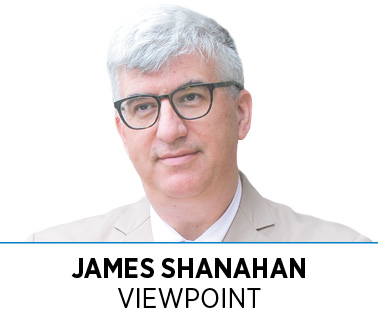The megamerger is really happening. Expect the new Gannett (NYSE:GCI) – the brand that will survive that chain’s acquisition by GateHouse Media (NYSE:NEWM) – to officially take wobbly flight soon, perhaps around Thanksgiving.
Both companies, the country’s No. 1 and No. 2 newspaper publishers, say it’s full speed ahead. Independent financial analysts tell me that their data-driven analysis shows a 90-percent-plus chance the merger completes. The deal has already gotten the blessing of the Department of Justice’s antitrust division; that approval flashes a very green light to all the other newspaper chains eyeing various mergers and recombinations.
First Published At Harvard’s Nieman Journalism Lab On Oct. 9, 2019
So by New Year’s Day 2020, all the companies’ news products across 265 markets will move under one giant umbrella. Never before in U.S. history have we seen a single company own and manage so much of the American newspaper business – about one of every six dailies. (Both companies are declining comment on the merger’s details at this juncture.)
In other words, it’s been a boffo opening season of The Consolidation Games, the newspaper-industry drama that’s played out in corporate offices, bank meeting rooms, and the stock market since the beginning of 2019 – and which is certain to be picked up for a second series in 2020. Readers, advertisers, and journalists will feel the reverberations of the Gannett-GateHouse merger for years to come:
- Expect aggressive early moves to begin achieving the $300 million in cost-cutting synergies the dealmakers have claimed to justify the deal.
- More than 10 percent of the chains’ combined workforce – about 25,000 in the United States – will likely get the dreaded call from HR that their services will no longer be needed. How big a cut will that be? If the headcount reduction reaches 3,000 – which would be 12 percent of the workforce – that’s the equivalent of McClatchy’s entire employee count. And McClatchy will be the second-largest newspaper chain in America after this merger is complete. New Gannett CEO Mike Reed has emphasized that the coming cuts will come almost entirely outside the newsrooms. Business-side functions – from advertising to production to finance to circulation – will take the brunt of the cuts. Most of the headcount cuts will come in the merged company’s first year, but some will bleed into the Year 2020.
- Fundamental to those cuts is the adoption of single, uniform systems across the enterprise. Think back to the year-plus of pain that one paper, the Los Angeles Times, went through to untangle itself from Tribune/Tronc’s centralized tech platforms. Now think of how time- and money-consuming it will be to do that across those 265 markets, and you get a sense of the multiyear synergy headache upcoming. Gannett and GateHouse each have largely centralized their newsroom tech stacks, with each relying largely on a singular content management system. Those will merge onto one CMS. Merging the companies’ much-touted digital marketing services businesses shouldn’t be particularly difficult, several sources tell me. But in most other business functions, a truly motley array of systems still abound. Worse yet, few are cloud-based and run centrally, meaning that even papers using the same software for the same functions are often using different locally installed versions of it.
The Calendar Ahead
The date to circle on your Consolidation Games calendar is November 14.2019. That’s the day both Gannett and GateHouse shareholders are scheduled to vote on the deal.
GateHouse’s NEWM stock got clobbered soon after the merger announcement, GateHouse down 33 percent over the next three trading sessions. It’s recovered some, but it’s still down 32 percent from the start of 2019. No one is wowed by this deal. It is a marriage of the possible, two partners without many other prospects. Given the ongoing pace of deterioration in newspapers’ operating numbers, that’s the best face even the dealmakers can put on it.
That’s also the pitch to shareholders: You’ll make more money with New Gannett than with either the old Gannett and old GateHouse. Or to put it in the financial speak of the roadshows conducted by the principals to reassure anxious investors: “Nobody has a better path to create value.” That’s shareholder value, of course.
These are two struggling companies seeking short-term salvation – enough oxygen to get a few more years down the road. Taking a $300 million whack at all the “redundancies” in day-to-day operations seems a better choice than going it alone. Sure, it’ll cost $100 million or so to cut all those jobs and rationalize all that tech – most of it in severance. But that’s far preferable, both Gannett and GateHouse believe than a thousand smaller cuts, atop the thousands both have already made.
Will shareholders buy that argument? The share prices say yes. While there have been several shareholder lawsuits, they look like the sort of attorney-cash-ins common in these kinds of mergers. Experienced financial observers tell me they shouldn’t hold up the deal.
Both Gannett and GateHouse shareholders will get the usual independent advice. Most likely before Halloween, the two major shareholder advisory companies will weigh in with their recommendations on how shareholders should look at the transaction.
ISS and Glass Lewis are now assessing the deal, though they haven’t yet approached the principals with questions. Their recommendations can be somewhat unpredictable; recall the odd call in May to put one of Alden Global Capital’s slate on the Gannett board, a bizarre ISS recommendation during Alden’s failed acquisition try. But both are likely to see the deal logic and say, at some length and in finance-speak, “Uh…okay.”
The companies can close the transaction within just a few days of shareholder approval. Expect that to happen in November, just before or after Thanksgiving.
That’s also when we’ll see the shape of the New Gannett’s new exec team. We know that Paul Bascobert, announced as CEO by (Old) Gannett at the time of the merger announcement has been touring the company’s offices. He touts the value of the deal and the company to come, while of course spending lots of time reassuring workers who see the ax hanging overhead. At the same time, Bascobert is doing his own assessment. Together with Reed, Bascobert’s first order of business will be a profound reorganization of the company.
A new slimmer structure – much more GateHouse-thin than Gannett-like – is on the way. Streamlining is the name of the game. Heads will roll, though a few of the highly placed Gannett ones will be attached smartly to golden parachutes. Gannett CFO Alison Engel will join Bascobert’s operating team, but the guessing game is on at both companies as to which other execs will ascend – and which won’t. The biggest question: the fate of current GateHouse (operating) CEO Kirk Davis, Mike Reed’s long-time business partner in building the company.
The New Company’s Priorities
All eyes will be on the New Gannett, but it’s tough to say what anyone will actually see.
CEO Mike Reed says he intends to maintain the cohort of journalists now working in both companies. Still, expect some cuts, likely small, in areas like statehouse coverage or regional/statewide sports, due to new regional clustering caused when nearby papers become New Gannett siblings. We can watch whether the company reinvests such resources in the enterprise/investigative teams both companies have built and publicly promoted.
But will there be any new investment? In the product? In the newsrooms? That’s one of the big questions here. The marketplace has not rewarded either company’s products; revenues keep sliding, and subscriptions – print or digital – haven’t nearly filled the gap caused by the great print ad decline.
But the financials in this deal cry out:Â Repay the debt first.
As I’ve reported, Apollo Global Management may have been the only financier ready to put in the $1.8 billion it took to put this deal together. And in doing so, Apollo was able to demand an 11.5 percent interest rate – an indication of both the risk in the deal and the cold shoulder other financiers gave it.
The impact: On Day 1, the New Gannett will have a mountain of debt to pay off. And the language of the loan allows it to repay it faster than its five-year term without penalty. The faster New Gannett pays off the debt, the less interest it pays, just like any working stiff with a credit card bill. The incentives to make debt payments Priority 1 are clear.
But! Also, consider that New Gannett is also promising its shareholders lots of earnings. In its filed financials, the company has painted a rather rosy picture of how it will improve those earnings – despite continuing deep ad decline and the threat of a recession that would likely further pressure revenue.
After they feed debt repayment and earnings, Reed and Bascobert will get to decide where to invest in their new company. How much will they have to work with?
The magic words here are “excess cash flow” – that’s the money the new company will have after it meets its basic obligations. If Reed’s projections will bear out, then perhaps substantial investments can be made. The history of the last few years, though, says there are significant odds against the company having enough cash to transform the business for the next decade – even if there is a strategic vision in place for how to spend it.
Mix-And-Match
So where does this outsized deal leave the prospects for other mergers and acquisitions?
Everyone I’ve spoken with close to that question says to expect very little to happen between now and the end of the year.
Looking into 2020, it’s noteworthy how relatively quickly this megamerger got the DOJ green light. The department’s antitrusters could have decried the big regional domination the New Gannett will have in states like Ohio and Florida. (Both pretty important places politically.) But they didn’t.
These same regulators had objected to what was then Tronc’s attempts to buy, separately, the Orange County Register in 2016 and the Chicago Sun-Times in 2017. In each case, DOJ didn’t want one company to own two big properties in a single market (alongside Tronc’s L.A. Times and Chicago Tribune).
In Gannett-GateHouse, there is no single city that hosts papers from each company. (There aren’t that many two-paper markets left, after all.) The clusters this merger will create are more regional. So the DOJ’s Tronc-era standard didn’t apply.
(In Florida, New Gannett will own dailies in Jacksonville, West Palm Beach, Sarasota, St. Augustine, Naples, Brevard County, Fort Myers, Pensacola, Tallahassee, Gainesville, Lakeland, Daytona Beach, Ocala, Winter Haven, Panama City, the Treasure Coast, the Space Coast, and more. In Ohio, it will own Columbus, Cincinnati, Akron, Canton, and more – three of the state’s four largest papers by weekday circulation.)
The pitch to regulators by Gannett and GateHouse attorneys came down to one word: “duopoly.” As in the Duopoly, Google (NASDAQ:GOOG) (NASDAQ:GOOGL) and Facebook (NASDAQ:FB), which dominate digital advertising at a scale multiples beyond what even the most mega of newspaper megamergers could dream of. They made the case that newspapers really can’t control ad pricing in any market, even if they owned clusters of papers adjacent to each other.
It appears DOJ bought that argument. If so, as the next waves of M&A conversations roll forth, would-be buyers and sellers believe they can remove the DOJ review concern (triggered by the Hart Scott Rodino Act) from the table.
(Of course, the DOJ isn’t exactly the same animal today as it was in previous administrations. Makan Delrahim is a former Trump White House deputy counsel who was confirmed as head of the antitrust division in September 2017. In an interview with The New York Times, he “emphasized that antitrust is intended to support free markets and that the government should intervene only when necessary. A monopoly is perfectly legal until it abuses its monopoly power, he said.”)
But it’ll take more than regulatory openness to get more mergers moving quickly. Every other newspaper company sees the same kind of cost-cutting synergies Gannett and GateHouse do. But they also learned a harder lesson from their tie-up: Deal financing, when it’s even possible, is really expensive. Apollo’s 11.5 percent rate is three or more points higher than the refinanced debt other companies such as McClatchy have negotiated recently. With tight cash flow and even tighter cash flow projections, every extra point of interest has a real impact – mostly in the accelerated cutting of jobs, including in newsrooms.
Right when Gannett and GateHouse shareholders are voting next month, each of the publicly-owned newspaper companies will be reporting its 3rd-quarter financials. There’s little evidence any of those will meaningfully revive the narrative of unending decline. When talk turns to M&A in 2020, the warts of all prospective mates will be in front of the mind.
Original Post
Editor’s Note:Â The summary bullets for this article were chosen by Seeking Alpha editors.



 Local newspapers have been in trouble for some time, with increasing concentration of ownership adding to the already dire prospects for advertising, subscription income and any other funding modes that might preserve locally reported and edited news.
Local newspapers have been in trouble for some time, with increasing concentration of ownership adding to the already dire prospects for advertising, subscription income and any other funding modes that might preserve locally reported and edited news.
